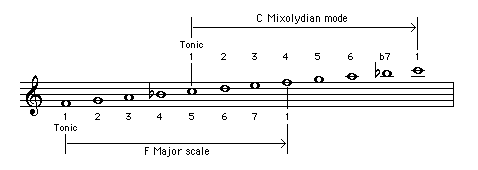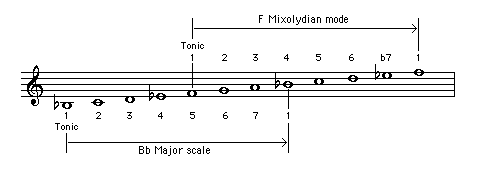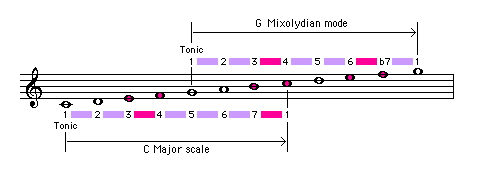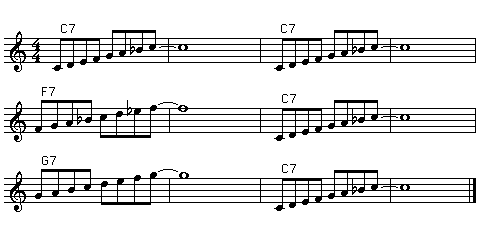(Down - Up - Top - Links)
BL 8.2 - The Mixolydian mode
If you have a closer look at the C Mixolydian mode, you will notice that it contains the same notes as the F major scale. The Mixolydian mode only starts on a different tonic note (C).
Audio 8.2

Likewise the F Mixolydian mode consists of the same notes as the Bb major scale,
Audio 8.3

and the G Mixolydian mode uses the same notes as the C major scale.
Audio 8.4

Therefore a Mixolydian mode can be formed from any major scale by starting on the 5th note of that major scale.
Although the major scale and related Mixolydian mode use the same notes, they still sound differently because the semitone intervals of the scale and mode occur at different points in relation to the tonic. This is a vital difference.

In a major scale the semitones are between notes 3 and 4, and between 7 and 1.
In the Mixolydian mode they occur between 3 and 4, and between 6 and b7.
The tonic (1st note) of a scale or mode, or the root (bottom note) of a chord represent the focal point ('key centre') at that point in the music.
Every other note is perceived by the listener in relation to that focal point. For example :
- Within the F major scale (or a melody segment with F as key centre) a Bb will be perceived by the listener as a perfect 4th interval.
- Within the C Mixolydian mode (or a melody segment with C as key centre) a Bb will be perceived by the listener as a minor 7th interval.
|
You will probably find it easiest to think of a Mixolydian mode as a Major scale (starting on the same tonic note) but with a b7. In time you may become more comfortable with the displaced tonic principle.
(Down - Up - Top - Links)
BL 8.3 - Mixolydian Blues Practice
In Mixolydian Blues the appropriate Mixolydian mode is used for each individual chord of the blues.
For the Blues in C use :
| C Mixolydian mode over C7
| C D E F G A Bb C
|
| F Mixolydian mode over F7
| F G A Bb C D Eb F
|
| G Mixolydian mode over G7
| G A B C D E F G
|
Audio 8.5

Play-along tracks for the Blues in C (all instrument use the C, F and G Mixolydian modes).
- C- instruments use bblc.mid (or any other track in C)
- Bb- instruments use bblbb.mid (or any other track in Bb)
- Eb- instruments use bbleb.mid (or any other track in Eb)
C-instruments also practise above routine for the blues in F and in G.
Bb-instruments also practise above routine for the blues in G and in A.
Eb-instruments also practise above routine for the blues in D and in E.
(Down - Up - Top - Links)
BL 8.4 - Come with Me
There are no 'blue notes' in the Mixolydian modes that clash with the blues chords. The b7 in the mode always coincides with a corresponding chord tone.
Blues melodies and improvisations that use Mixolydian modes have therefore a very clean and clear sound which contrasts sharply with the usual 'dirty blues'.
The Mixolydian modes can provide a strong musical contrast to the blues scale in a blues improvisation. This is most useful when soloing for several choruses. You can start for example with a couple of choruses using the minor pentatonic, follow it by adding the 5b (blues scale), then come clean with a few choruses using Mixolydian modes.
Come with Me features a blues melody entirely composed of notes from the three underlying Mixolydian modes.
Melody

Play-along tracks for the Blues in C (all instrument use the C, F and G Mixolydian modes).
- C- instruments use bblc.mid (or any other track in C)
- Bb- instruments use bblbb.mid (or any other track in Bb)
- Eb- instruments use bbleb.mid (or any other track in Eb)